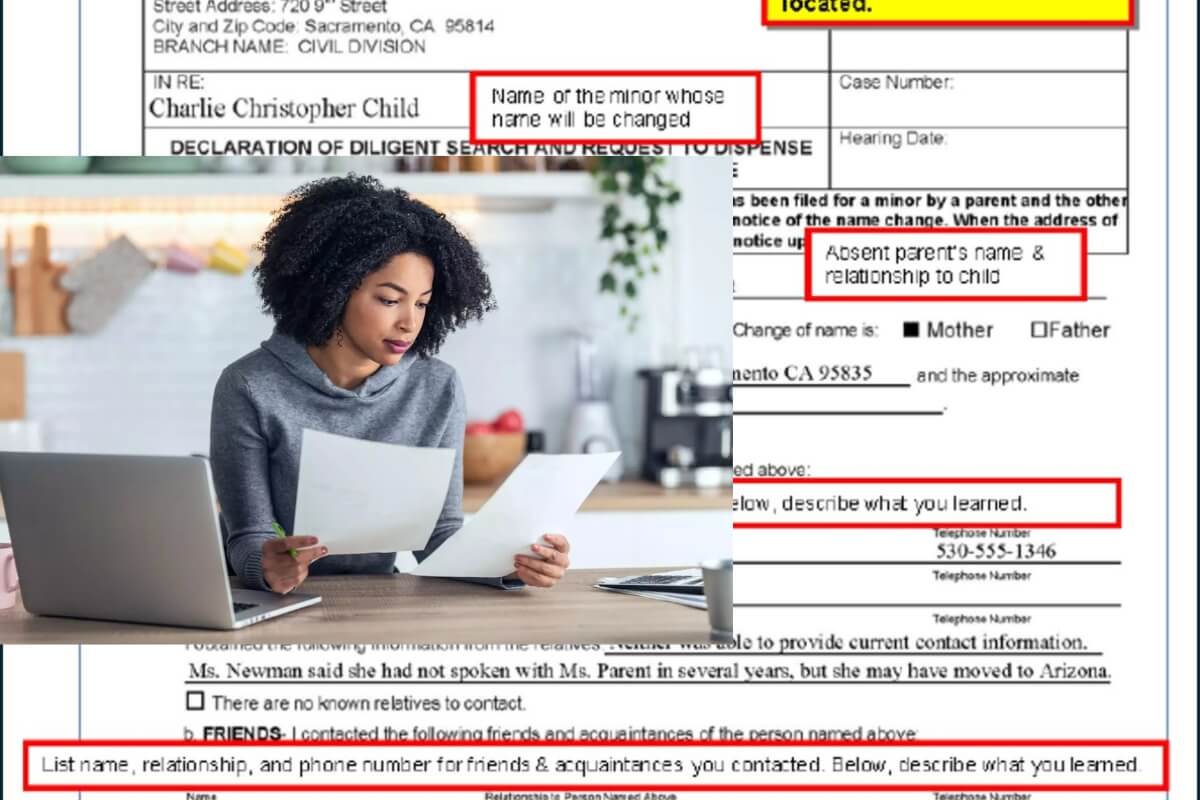How to Legally Change Your Child’s Name in California

If you’re a parent looking to legally change your child’s name in California, this Extensive, guide will walk you through the entire process step-by-step. We’ll cover the reasons for changing a minor’s name, the required legal steps, costs involved, and how to update your child’s official records after the name change is approved.
Understanding the Legal Name Change Process for Minors in California
Changing a child’s legal name in California is a straightforward process, but it does require following some specific court procedures. As a parent, you have the right to petition the court to legally change your child’s first, middle, or last name – or even all three.
Reasons for Changing a Child’s Name
There are a variety of valid reasons why a parent may want to legally change their child’s name in California, including:
- After Marriage or Divorce: You may want your child to share the same last name as you or your new spouse after marriage. Conversely, a parent may choose to revert their child’s last name to their maiden name after a divorce.
- Correcting a Name on the Birth Certificate: Sometimes parents make a hasty decision on their child’s name at birth and later want to change it. This is a common reason for a name change petition.
- Honoring Family Traditions: Parents may choose to change their child’s last name to honor a grandparent, ancestor, or other family member.
- Aligning with Gender Identity: Transgender or non-binary children may want their first name changed to match their gender identity.
- Child Adoption: When a child is adopted, the adoptive parents often want to give the child their new family’s surname.
Can a Mother Change a Child’s Last Name Without Father’s Consent?
Yes, a mother can legally change her child’s last name in California without the father’s consent, as long as the proper legal procedures are followed. This includes serving the non-custodial parent with notice of the name change petition.
However, if the other parent objects to the name change, the judge will need to evaluate the case and make a decision based on the child’s best interests. Ultimately, the judge has the final say on whether to approve or deny the name change request.
What If One Parent Is Not in the Picture or Doesn’t Agree?
Even if one parent is absent or disagrees with changing the child’s name, you can still petition the court to legally change your child’s name. The key is to properly serve the non-custodial parent with notice of the name change request.
If personal service isn’t possible because the other parent’s location is unknown, you’ll need to explain this to the court and request an alternative method of service, such as publication in a local newspaper. The judge will then decide whether to waive the personal service requirement.
Ultimately, the court’s decision will hinge on whether the name change is in the child’s best interests, regardless of one parent’s objections.
Steps to Legally Change Your Child’s Name in California
The process of legally changing a child’s name in California involves several key steps that must be carefully followed. Let’s walk through each one:
Filing the Petition for Change of Name
To begin, you’ll need to obtain the necessary court forms from your local superior court. The main forms required are:
- Petition for Change of Name (Form NC-100)
- Attachment to Petition for Change of Name (Form NC-110)
- Order to Show Cause for Change of Name (Form NC-120)
- Decree Changing Name (Form NC-130)
- Civil Case Cover Sheet (Form CM-010)
You’ll need to complete these forms, make copies, and file them with the court, along with paying the required filing fee (typically between $435-$480).
Serving the Other Parent and Proof of Service
Once you’ve filed the petition, you must arrange for the other parent to be “served” with a copy of the Order to Show Cause (Form NC-120). This is usually done by having an adult who is not involved in the case personally deliver the documents to the other parent.
After service is complete, the server must fill out a Proof of Service form (NC-121) documenting when, where, and how the other parent was served. This proof of service must be filed with the court prior to the scheduled hearing date.
Publishing the Name Change Request
California law requires that you publish your name change request in a local newspaper of general circulation once a week for four consecutive weeks before your court hearing. This helps ensure public notice of the proposed name change.
You’ll need to contact a qualifying newspaper, provide them with the Order to Show Cause (Form NC-120), and pay their publication fees (typically $80-$130). The newspaper will then file a Proof of Publication with the court on your behalf.
Attending the Court Hearing
At the scheduled court hearing, you’ll need to appear before the judge to finalize the name change. If the other parent does not object, the judge will likely approve your request without further issues.
However, if the other parent opposes the name change, the judge will need to evaluate the case and determine whether the name change is in the child’s best interests. The judge may ask you and the other parent questions during the hearing.
Obtaining the Decree Changing Name
If the judge approves your petition, they will sign a court order called a “Decree Changing Name” (Form NC-130). This official document is the proof you’ll need to update your child’s legal identification and records.
Be sure to obtain several certified copies of the Decree from the court clerk, as you’ll need these to update your child’s birth certificate, social security card, driver’s license, and other official documents.
Costs and Fees for Changing a Child’s Name in California
The overall cost to legally change a child’s name in California can vary, but you should expect to pay the following:
Court Filing Fees
The filing fee to submit the name change petition with the court is typically between $435 and $480, depending on the county. If you cannot afford this fee, you can request a fee waiver from the court.
Publication Costs
You’ll need to pay the newspaper a fee to publish the name change request for four consecutive weeks. This usually costs between $80 and $130, but can be as high as $500 in some cases.
Other Associated Expenses
Additional costs may include:
- Serving the other parent ($40-$100 for personal service)
- Obtaining certified copies of the Decree Changing Name ($25.50 per copy)
- Amending the birth certificate ($23 per certified copy)
The total cost to legally change a child’s name in California can range from $700 to $800 or more, depending on your specific situation and any additional services required.
Updating Legal Documents After the Name Change
Once you have the signed Decree Changing Name from the court, you’ll need to use that document to update your child’s official records and identification. Here’s how to handle the most common documents:
Changing the Name on Birth Certificate
If your child was born in California, you’ll need to contact the California Department of Public Health Vital Records office to obtain an amended birth certificate reflecting the new name. This typically requires submitting Form VS-23 and providing a copy of the Decree Changing Name.
Updating Social Security Records
You’ll need to visit your local Social Security office with the Decree Changing Name to update your child’s social security card and records to reflect the new legal name.
Modifying Driver’s License and ID Cards
Take the Decree Changing Name to your local DMV office to have your child’s driver’s license or state ID card reissued with the new name.
Notifying Other Agencies and Institutions
You may also need to update your child’s name with their school, medical providers, banks, and other relevant organizations by providing a copy of the Decree Changing Name.
Pros and Cons of Legally Changing Your Child’s Name
As with any major decision, there are both benefits and potential drawbacks to consider when changing your child’s legal name. Let’s explore some of the key factors:
Benefits of Changing Your Child’s Name
- Sense of Identity and Belonging: A name change can help your child feel a stronger connection to your family and their own sense of self.
- Easier Daily Life: Sharing the same last name as parents and siblings can simplify things like school enrollment, medical forms, and travel.
- Honoring Family Traditions: Carrying on a family surname or naming heritage can be an important way to preserve your cultural identity.
Potential Drawbacks to Consider
- Updating Official Records: You’ll need to update your child’s birth certificate, social security card, and other ID documents, which can take time and effort.
- Potential Confusion: A name change, especially for an older child, may cause some temporary confusion or adjustments with family, friends, and institutions.
- Objections from the Other Parent: If the child’s other parent disagrees with the name change, the legal process may become more complex.
Overall, as long as you follow the proper legal procedures, changing your child’s name in California can be a positive and meaningful step for your family. The key is ensuring the change is in the best interest of your child.
Conclusion – Making the Right Decision for Your Family
Legally changing your child’s name in California is a straightforward process, but it does require careful adherence to the state’s specific court procedures. By understanding the reasons for a name change, the required steps, associated costs, and the process of updating official records, you can make an informed decision that’s in the best interests of your child and your family.
Remember, the ultimate goal of a name change is to provide your child with a sense of identity, belonging, and empowerment. With patience and the right legal guidance, you can navigate this process successfully and give your child the name that fits them best.






